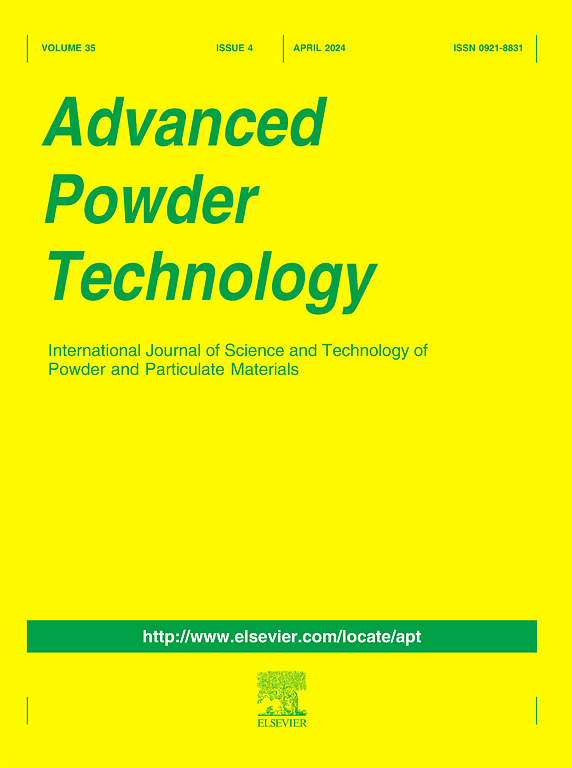Control of temperature rise during wet stirred media milling
IF 4.2
2区 工程技术
Q2 ENGINEERING, CHEMICAL
引用次数: 0
Abstract
Temperature increases during wet stirred media milling (WSMM) significantly, which may cause degradation of thermolabile drugs. This study aims to examine the impacts of batch size, pre-cooling, and cooling rate on product temperature under various milling conditions. To this end, a lab-scale mill was used along with a small batch (∼0.22 L) and a large batch (∼5.4 L) of CaCO3 suspension. For the 5.4 L batches, the impacts of stirrer speed and bead loading–size on particle size and temperature were investigated experimentally and simulated by an enthalpy balance model (EBM). Our results suggest that the median size was lower (median size x50 as low as 0.227 µm), and the temperature was higher (with the maximum temperature rise of 27 °C) at the higher stirrer speed with a higher bead loading, whereas the bead size impact was weak. The temperature rise was 4–8 °C lower for the smaller batch than for the larger batch. Besides predicting the milling parameters’ impacts, the EBM suggests that lowering coolant temperature was the most effective to control product temperature, whereas a low suspension flow rate could be detrimental, and pre-cooling had limited favorable impact. Overall, we conclude that batch size, coolant temperature, pre-cooling, and suspension flow rate can be adjusted, as guided by EBM, to control temperature during WSMM. These findings offer practical guidance for controlling thermal conditions in WSMM and improving scalability and product quality in pharmaceutical manufacturing.

湿搅拌介质制粉过程中温升的控制
湿搅拌介质制粉过程中温度升高明显,可能导致耐热性药物的降解。本研究旨在探讨在不同的制粉条件下,批量大小、预冷和冷却速度对产品温度的影响。为此,使用了实验室规模的研磨机,同时使用了小批量(~ 0.22 L)和大批量(~ 5.4 L) CaCO3悬浮液。采用焓平衡模型(EBM)对5.4 L物料进行了实验研究,研究了搅拌速度和颗粒粒径对物料粒度和温度的影响。我们的研究结果表明,在较高的搅拌速度和较高的球头载荷下,球头尺寸的影响较小(中位数尺寸x50低至0.227µm),温度较高(最高温升27°C),而球头尺寸的影响较小。小批量的温升比大批量低4-8℃。除了预测铣削参数的影响外,EBM还表明,降低冷却液温度是控制产品温度最有效的方法,而低悬浮流速可能是有害的,预冷的有利影响有限。总的来说,我们得出结论,在EBM的指导下,可以调整批量、冷却剂温度、预冷和悬浮流速,以控制WSMM过程中的温度。这些发现为控制WSMM的热条件,提高制药生产的可扩展性和产品质量提供了实用指导。
本文章由计算机程序翻译,如有差异,请以英文原文为准。
求助全文
约1分钟内获得全文
求助全文
来源期刊

Advanced Powder Technology
工程技术-工程:化工
CiteScore
9.50
自引率
7.70%
发文量
424
审稿时长
55 days
期刊介绍:
The aim of Advanced Powder Technology is to meet the demand for an international journal that integrates all aspects of science and technology research on powder and particulate materials. The journal fulfills this purpose by publishing original research papers, rapid communications, reviews, and translated articles by prominent researchers worldwide.
The editorial work of Advanced Powder Technology, which was founded as the International Journal of the Society of Powder Technology, Japan, is now shared by distinguished board members, who operate in a unique framework designed to respond to the increasing global demand for articles on not only powder and particles, but also on various materials produced from them.
Advanced Powder Technology covers various areas, but a discussion of powder and particles is required in articles. Topics include: Production of powder and particulate materials in gases and liquids(nanoparticles, fine ceramics, pharmaceuticals, novel functional materials, etc.); Aerosol and colloidal processing; Powder and particle characterization; Dynamics and phenomena; Calculation and simulation (CFD, DEM, Monte Carlo method, population balance, etc.); Measurement and control of powder processes; Particle modification; Comminution; Powder handling and operations (storage, transport, granulation, separation, fluidization, etc.)
 求助内容:
求助内容: 应助结果提醒方式:
应助结果提醒方式:


